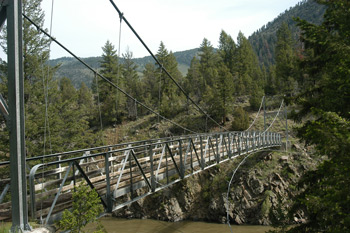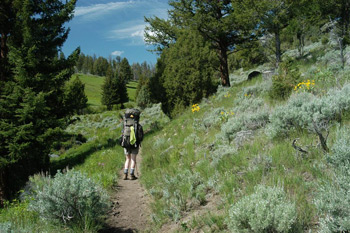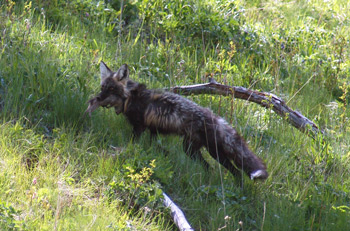Black Canyon of the Yellowstone
Searching for water
Friday, June 17
 As we crawled out of the tent, it did not take much effort to get ready for this glorious morning. Lots of sunshine, a few scatted clouds, and an easy hike ahead of us. Breakfast was a simple affair under our tarp, and it seemed to require all of the requisite two hours for us to break camp. We have tried over the years to reduce the time from tent crawl out to pack hoisting to something less than 120 minutes, but to not much avail. But as indicated, we had a relatively easy day ahead of us. First off, we needed to get back to the trail. I noticed for the first time the huge basalt extrusions on the cliff face above our camp. Reminded us of Devil's Post Pile National Monument in the Sierras. Susie wanted to stop and take better photos of the massive bridge across the Yellowstone. She did so, while I waited and examined trail maps. Our hike would take us first on a climb out of Yellowstone canyon. The only way out in this region of the river is up from the mouth of Blacktail Deer Creek on the Blacktail Creek trail. The climb is steady, but not too bad. Susie commented that it was a lot easier going up the trail on a sunny day, than sliding down it in the rain, like she had done the previous month. It was indeed a lovely day for hiking: cool temperatures, puffy white clouds and lots of blue skies and sweeping vistas.
As we crawled out of the tent, it did not take much effort to get ready for this glorious morning. Lots of sunshine, a few scatted clouds, and an easy hike ahead of us. Breakfast was a simple affair under our tarp, and it seemed to require all of the requisite two hours for us to break camp. We have tried over the years to reduce the time from tent crawl out to pack hoisting to something less than 120 minutes, but to not much avail. But as indicated, we had a relatively easy day ahead of us. First off, we needed to get back to the trail. I noticed for the first time the huge basalt extrusions on the cliff face above our camp. Reminded us of Devil's Post Pile National Monument in the Sierras. Susie wanted to stop and take better photos of the massive bridge across the Yellowstone. She did so, while I waited and examined trail maps. Our hike would take us first on a climb out of Yellowstone canyon. The only way out in this region of the river is up from the mouth of Blacktail Deer Creek on the Blacktail Creek trail. The climb is steady, but not too bad. Susie commented that it was a lot easier going up the trail on a sunny day, than sliding down it in the rain, like she had done the previous month. It was indeed a lovely day for hiking: cool temperatures, puffy white clouds and lots of blue skies and sweeping vistas.
We met a family day hiking in from the north road, but otherwise, things were relatively quiet on this Friday. Flowers were blooming everywhere, with the arrowleaf balsam root especially spectacular. As we climbed out of the cleft formed by the creek and out into the open spaces, I started focusing on what I expected to be the flow of creeks in from the west. I was surprised to see little water, except in the main creek. We met a guided horse party, just out for a day ride. I had asked if they were spending the night, but the guide indicated that overnight horse trips were not permitted in the park until July 1. As we continued to climb over the crests of gentle hills, we moved further and further away from Blacktail Deer Creek. Up ahead, I could see Susie stopped by a trail sign. I thought: if that is our trail junction, where was the water coming out of Rescue Creek, that we should have crossed a half a mile ago. I commented as much to her, and we agreed that if we did not run into water near the campsite, we would have to hike all the way out on this day. Since we had a water treatment pump with us, I figured we could handle most any sort of flowing liquid, as long as it was not pure bison pee.
 We turned west and hiked west about a half a mile or so, and stopped at a viewpoint overlooking what seemed to be a wet meadow to our northwest. It was lunch time, and a good spot for a rest. I started thinking that maybe Rescue Creek was not a mighty river, but rather a small trickle, and that it fed this meadow and then got absorbed into the ground. After lunch, we descended slightly to cross the downstream end of the meadow, and as we hopped over the outlet water course, eureka, there was water. Not a lot, but enough to pump into our water bottles. I was feeling better already. We drank up and headed west on the trail, toward our campsite. The trail runs along the north side of the meadow/marsh, and we noticed at one point that we were below the main trail, although clearly on a trail. About this time, I looked out to the west southwest and noticed a blaze orange placard and figured that it must signify camp, since it was in the right location. By this time, we were at the west end of the meadow, so it was just a matter of dropping down a bit, crossing over, and coming into camp. I could hear water trickling, and realized that the feeder stream, Rescue Creek, was flowing down the hill against which the campsite was nestled. No, it was not large (but by canyon standards, it was superb), and the site looked nice. Scattered trees on the south side of the meadow, and a nice cooking spot about a hundred meters west of the best place to set up a tent. It would be home for the night. One of the guidebooks refers to this as one of the best campsites in the park. This being only my second night in the backcountry of Yellowstone, I had little with which to compare, but it had some good views to the east, and while I have had lots of vastly more spectacular camps, this one was quite pleasant.
We turned west and hiked west about a half a mile or so, and stopped at a viewpoint overlooking what seemed to be a wet meadow to our northwest. It was lunch time, and a good spot for a rest. I started thinking that maybe Rescue Creek was not a mighty river, but rather a small trickle, and that it fed this meadow and then got absorbed into the ground. After lunch, we descended slightly to cross the downstream end of the meadow, and as we hopped over the outlet water course, eureka, there was water. Not a lot, but enough to pump into our water bottles. I was feeling better already. We drank up and headed west on the trail, toward our campsite. The trail runs along the north side of the meadow/marsh, and we noticed at one point that we were below the main trail, although clearly on a trail. About this time, I looked out to the west southwest and noticed a blaze orange placard and figured that it must signify camp, since it was in the right location. By this time, we were at the west end of the meadow, so it was just a matter of dropping down a bit, crossing over, and coming into camp. I could hear water trickling, and realized that the feeder stream, Rescue Creek, was flowing down the hill against which the campsite was nestled. No, it was not large (but by canyon standards, it was superb), and the site looked nice. Scattered trees on the south side of the meadow, and a nice cooking spot about a hundred meters west of the best place to set up a tent. It would be home for the night. One of the guidebooks refers to this as one of the best campsites in the park. This being only my second night in the backcountry of Yellowstone, I had little with which to compare, but it had some good views to the east, and while I have had lots of vastly more spectacular camps, this one was quite pleasant.
 The bugs were annoying Susie - they always seem to find her first - so she climbed into the tent after we got it set up, while I puttered around. There was a pronghorn antelope off in the distance to the west, and it seemed to want to come eastward, but seemed understandably shy about passing too near to our camp. I grabbed my longer lens and walked out into the open, to see if I could get a photo of it. It was still a long way away, so I walked westward. As I did, I caught some movement out to my left. Then, I saw some dirt spraying up into the air. Whatever it was seemed either to have missed me, or not to care about my presence. I approached slowly and carefully, and was treated to the sight of a ground squirrel becoming a late afternoon meal for a fox. Not good for the ground squirrel, but a treat to see the natural processes occurring. I took about 30 photos with a lens the equivalent of a 300 mm for a 35 mm camera. I got a couple that were "keepers." Such is wildlife photography. I spent some more time just prowling around. As close as we were to the solstice, it would be a long afternoon and evening.
The bugs were annoying Susie - they always seem to find her first - so she climbed into the tent after we got it set up, while I puttered around. There was a pronghorn antelope off in the distance to the west, and it seemed to want to come eastward, but seemed understandably shy about passing too near to our camp. I grabbed my longer lens and walked out into the open, to see if I could get a photo of it. It was still a long way away, so I walked westward. As I did, I caught some movement out to my left. Then, I saw some dirt spraying up into the air. Whatever it was seemed either to have missed me, or not to care about my presence. I approached slowly and carefully, and was treated to the sight of a ground squirrel becoming a late afternoon meal for a fox. Not good for the ground squirrel, but a treat to see the natural processes occurring. I took about 30 photos with a lens the equivalent of a 300 mm for a 35 mm camera. I got a couple that were "keepers." Such is wildlife photography. I spent some more time just prowling around. As close as we were to the solstice, it would be a long afternoon and evening.
After a couple more hours of goofing off, we decided it was time for dinner. We kept an eye on what we think was the same pronghorn antelope that I was seeing earlier in the day. He (or she - I have not learned to sex antelopes yet) skirted out camp way up on the hill, and after getting 300 meters to our east, decided to return to our level. After dinner, it was a short walk, always keeping the bear spray within easy reach, to get a good overview of the valley in which we were camped, and a preview of the morning's route. We crawled into bed well before dark, being tired and having seen much of what there was to see around us.
© Roger A. Jenkins, Suzanne A. McDonald, 2005
